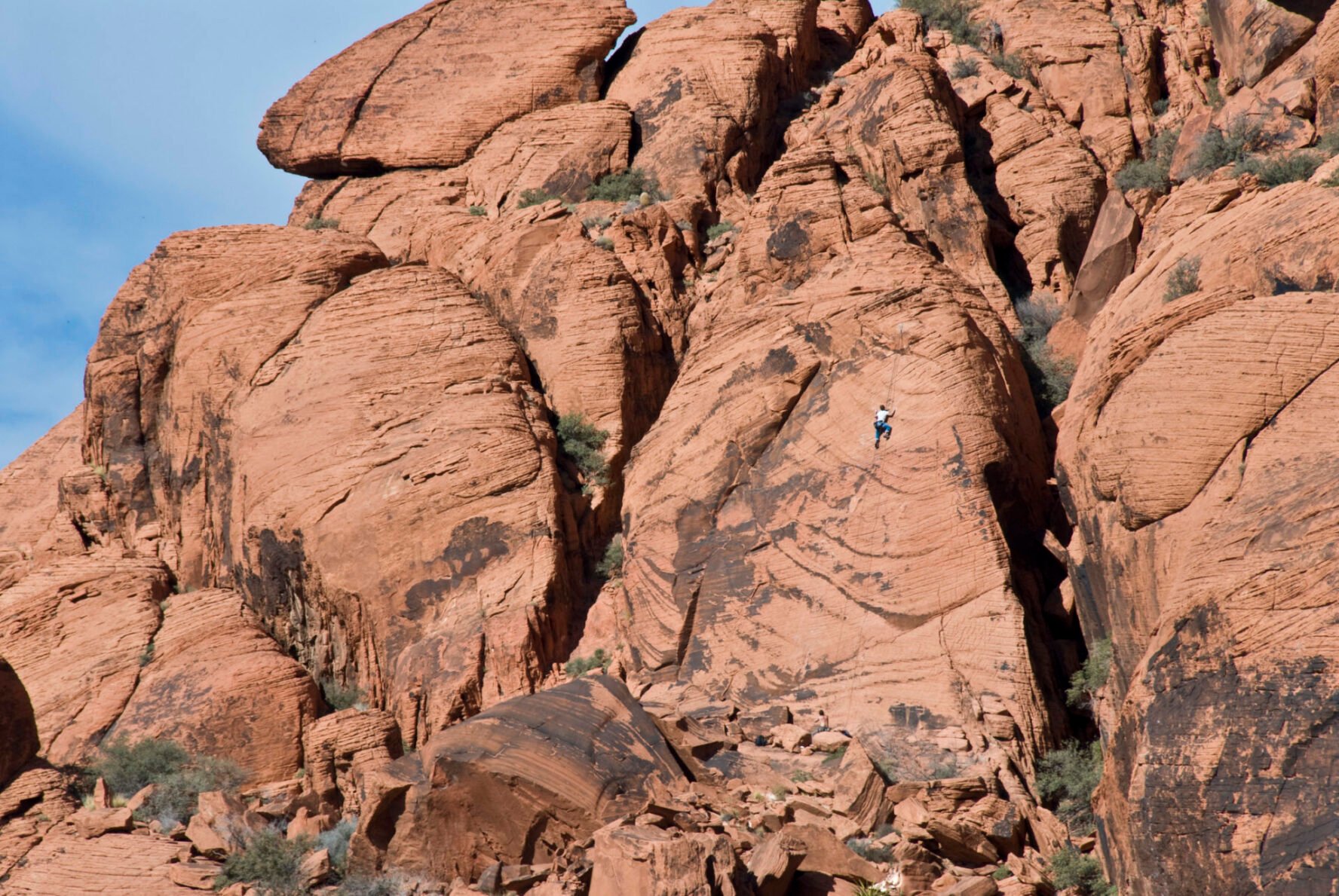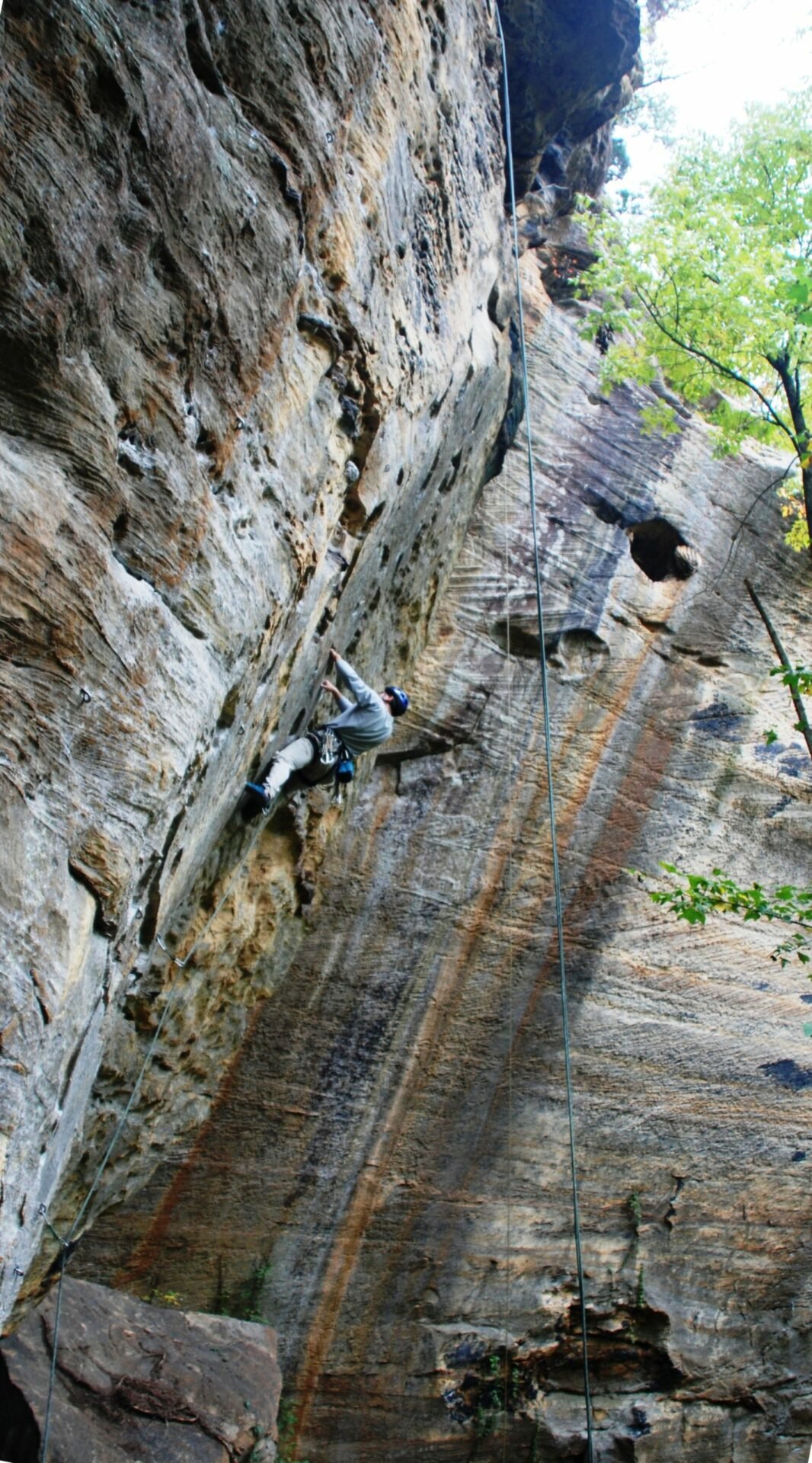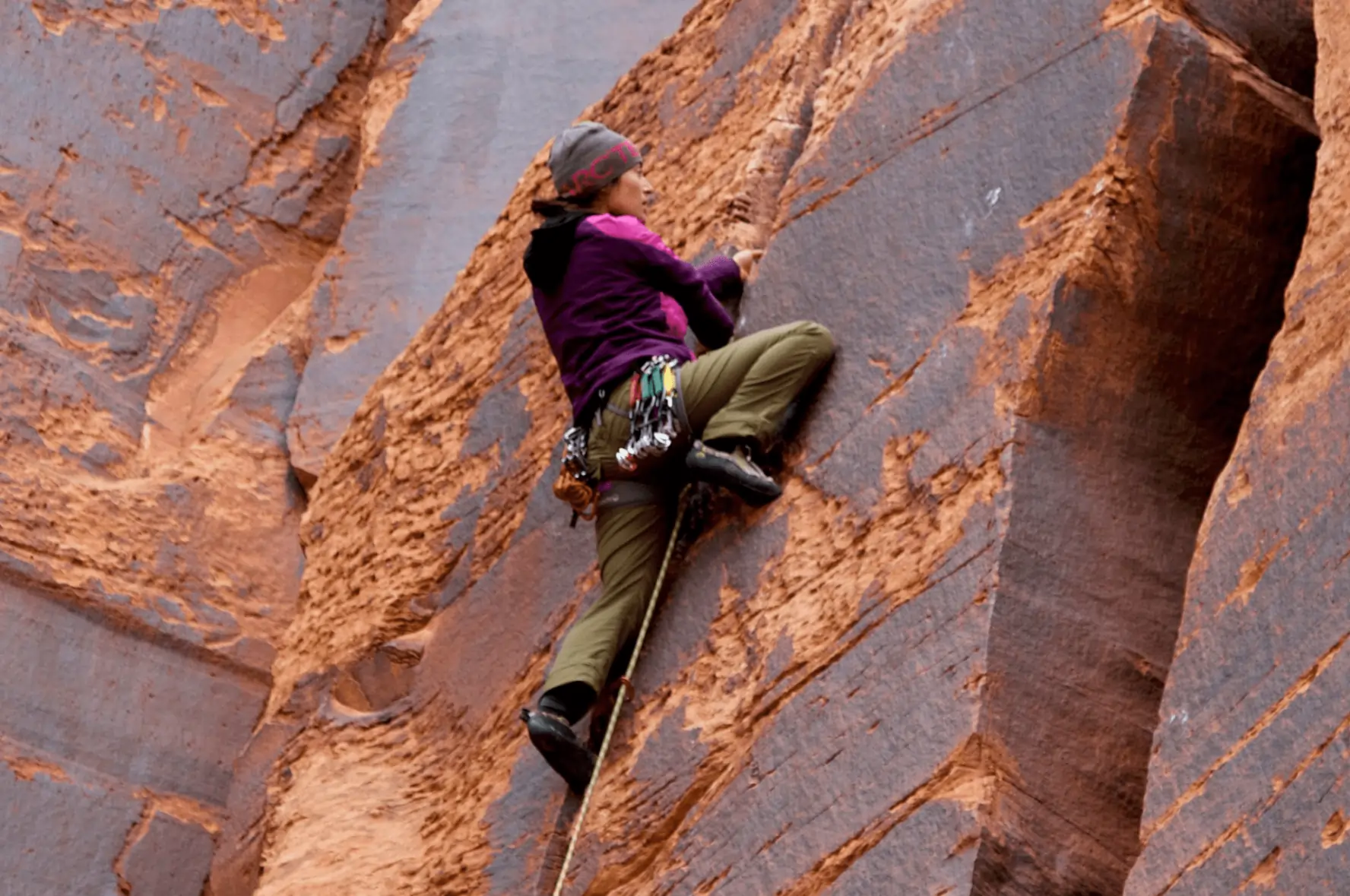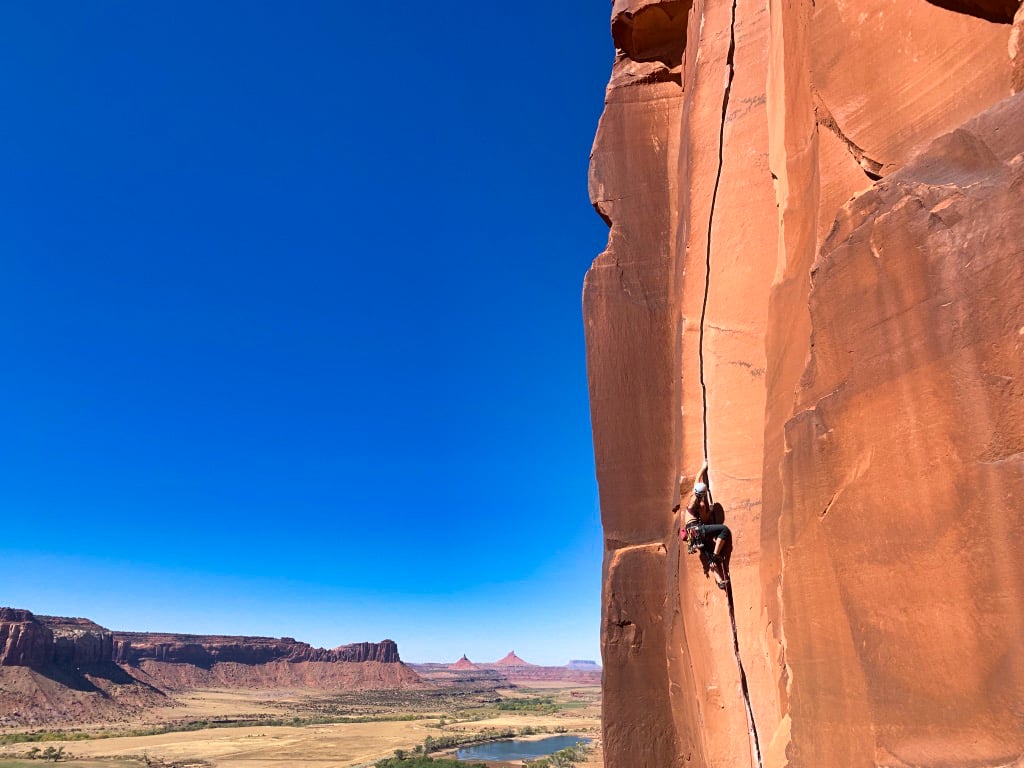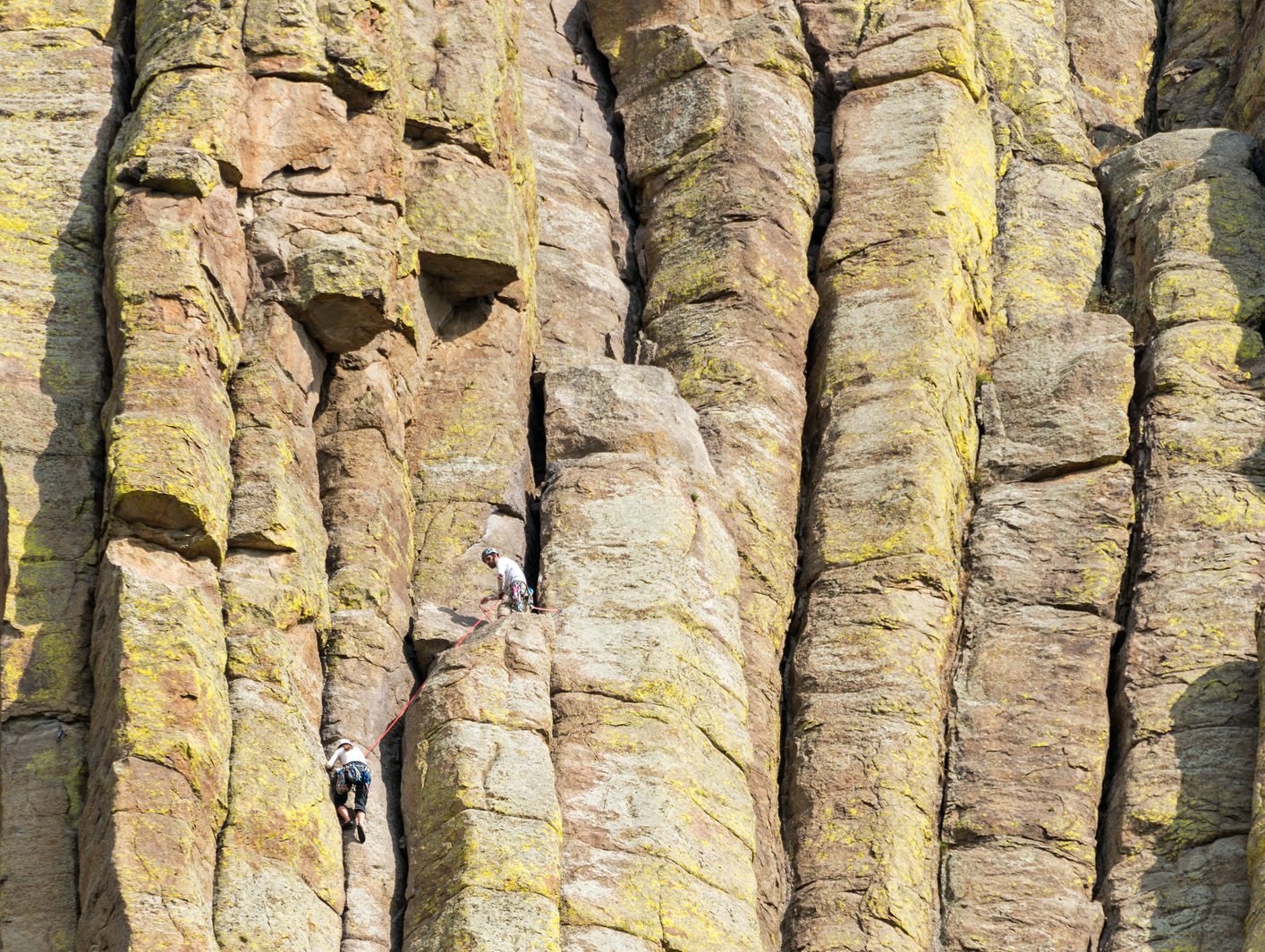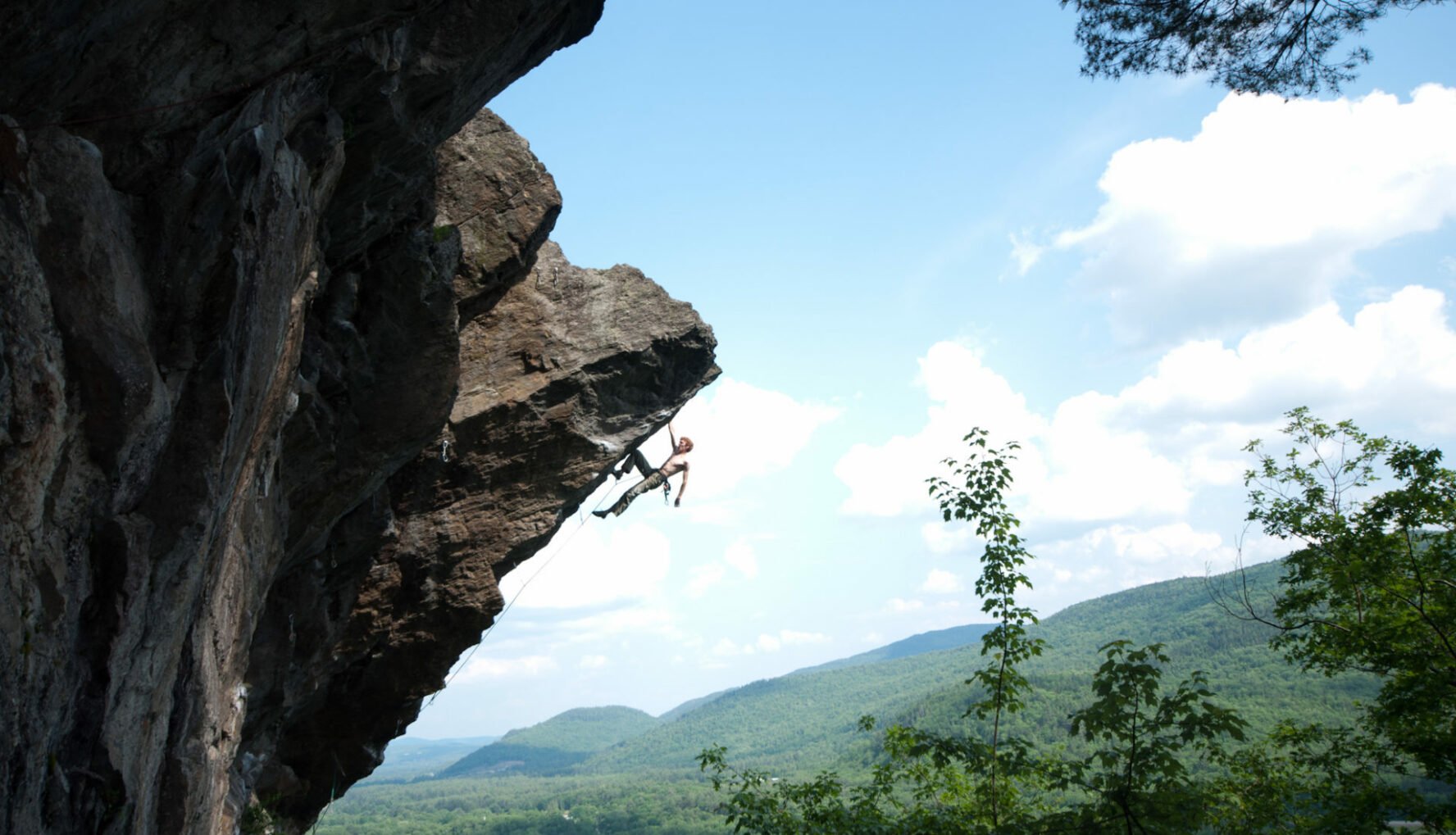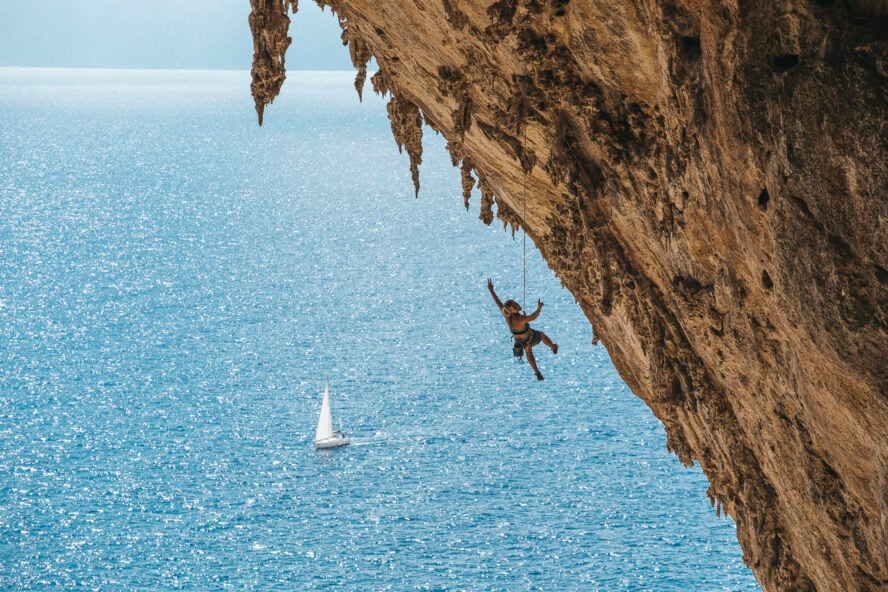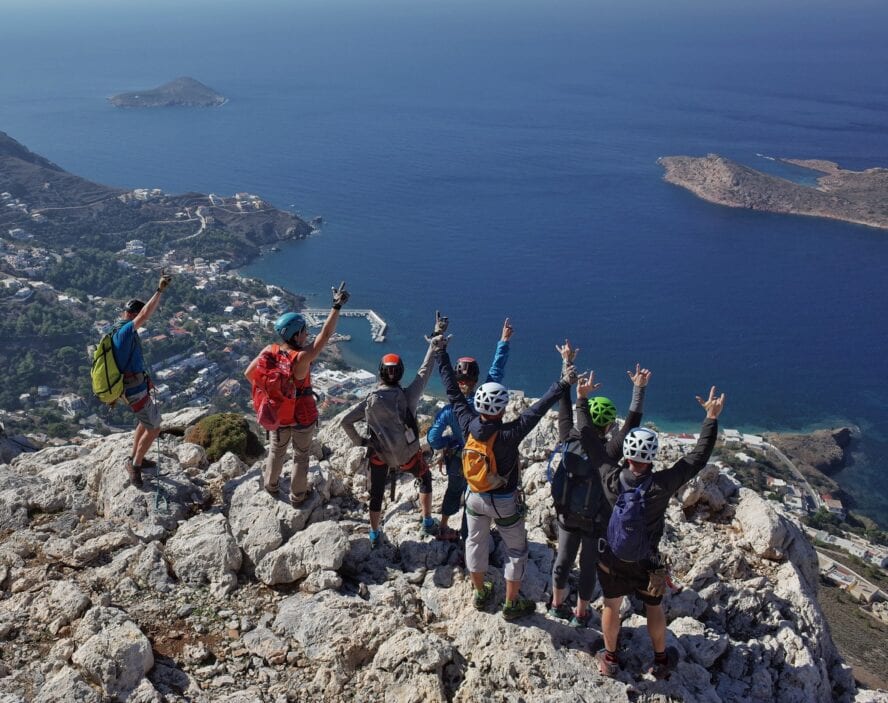When it comes to rock climbing adventures, it doesn’t matter what you’re looking for, the USA delivers. From the grand alpine endeavors of the Pacific Northwest to the steep, hidden cliffs of the southeastern corner, from the arid landscapes of the western deserts to the rolling hills of the midwest — America has rock climbing covered. The sheer vastness of the USA, the myriad of rock types, styles and quality make it home to several of the best places for rock climbing in the world. Whether you’re traveling from afar or looking for your next local adventure, here’s our list of the best places to rock climb in the USA.
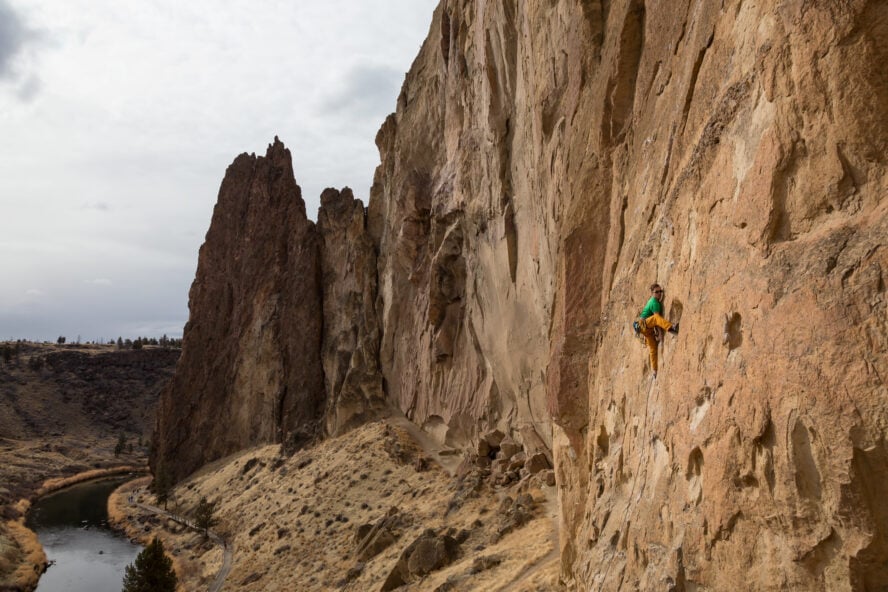
For the best climbing in the world, look no further than your own backyard
I once lamented the absence of international travel in my life. I filled my refrigerator with pictures of far away landscapes, of the cultures, destinations, and eventually, the climbing that I hoped to one day challenge myself with. It took a number of years before I realized that there was a world’s worth of climbing right here in my home country. There is so much climbing to discover, which is why I haven’t made any region my official full-time home just yet.
Alongside my partner, we seem to be changing scenery every couple of months when the need to discover a new destination arises. In any given year, I find myself all over the country, traveling where the climbing and the guiding work takes me, and I feel incredibly lucky to have this ability. I have had the chance to play in these places, some of which I have even called home for a little while.
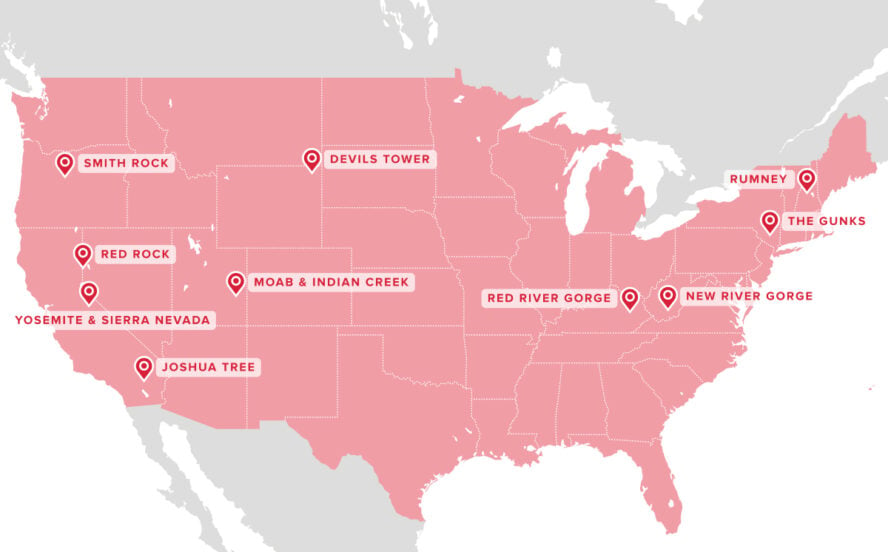
Whatever the type of rock climbing you’re after, you’re bound to see it on this list! Here are the 12 best places to rock climb in the USA:
1. Red Rock
Most visitors arrive in Las Vegas and never glance away from the dazzling light displays playing out as you walk down the strip with your four-foot-tall margarita glass in hand. Yes, the scenes of the Las Vegas Strip can be overwhelming, but even more so is the striking, otherworldly skyline just west of town that is the Red Rock National Conservation Area. Made of a unique type of sandstone, this enormous escarpment, which can reach heights of over 2,000 vertical feet, lends itself very well to free climbing. When I arrive at a location like Yosemite, I can’t help but think that I may never free a route on El Cap, but when I gaze up at Mt. Wilson, front and center in the Red Rock, I can point out numerous routes below 5.12 most of which rise to its summit).
World-class climbing in Calico Hills
The black desert varnish, weathered by time alongside the crack systems normally associated with sandstone, leads Red Rock to be considered “5.7 Heaven” or “Moderate Mecca” for individuals looking to amp up their mountain game on the rock. However, when I go cragging in Red Rock, it’s not always the towering objectives I seek. Red Rock also has world-class single-pitch sport and trad climbing in an area known as the Calico Hills. These tri-colored mounds of cliffs offer cracks, slabs, overhangs, vertical crimps, jugs, slopers, and even a few short multi-pitches. All grades can be encountered at almost any of the main areas.
The one-way scenic loop can make for tricky logistics
No matter the type of climbing you’re after, from the First Pullout (Calico I) to Oak Creek Canyon, objectives and crags must be accessed via the 13-mile, one-way scenic loop (which costs $15 per vehicle unless you have an Interagency Pass). Other areas like Calico Basin can be accessed outside of the park, as well as Oak Creek Canyon (an additional mile of walking) to Black Velvet Canyon and the Southern Outcrops. There is also great bouldering available at Kraft Mountain and scattered throughout the many canyons.
Know the local climbing etiquette
If you do plan a trip to climb Red Rock’s famous red sandstone, make sure you know the local climbing etiquette in Red Rock. In addition to not climbing on wet rock, there are a number of other things you need to be aware of to climb responsibly here and ensure that the area is preserved for future climbing generations.
I spend about two or three months out of the year climbing and guiding in Red Rock – it’s my favorite place on earth.
Red Rock - Good to Know
Trad, sport, bouldering
Aztec Sandstone
Fall, winter, spring
Calico Basin
Hiking the canyons, mountain biking, or test your luck in Vegas
2. Red River Gorge
I first tried the Red River Gorge climbing in 2010 after a peer described it as “the biggest holds you will ever fall off.” With a reputation like that, I just had to throw myself at the impressively steep lines. Home to some of the most spectacular and unique sandstone this side of Thailand rock climbing, the Red River Gorge — “The Red,” as it’s known to most climbers — is where you can climb some of the best single-pitch sport routes, not just in the entire country, but in the world, with some of them rivaling the massive single-pitches you find rock climbing in Canada.
Get started at Bruise Brothers
On my first trip to the Red in 2010, I immediately visited Muir Valley (now managed by Friends of Muir Valley) and gave the Solarium a try. After failing on a shot at Banshee (5.11c), I decided to ask the local guide service for some advice to better acclimate. I found myself at Bruise Brothers on some more short, but thought-provoking lines, realizing that the Red is far more than just viciously steep walls. I discovered thin, vertical lines at Bruise Brothers, steep jugs at the Motherlode, amazing splitter trad lines at Indian Creek and the Long Wall, and even a tower or two and a couple of multi-pitch lines!
When should you head to the Red?
The Red River Gorge is located about 60 miles southeast of Lexington, Kentucky, around a town called Slade, which is the best location to check for a weather forecast. The weather can be wet, so have a plan. Typically, afternoon storms are short, and many steep lines will either dry quickly or stay completely dry. Fall is the driest of the seasons. Get yourself to the Bert T. Combs Mountain Parkway and eventually take the KY-11 right into Slade.
Miguel’s is where the climbing scene lives
Just south of Slade, you’ll find Miguel’s Pizza, the premier climbing scene at the Red. Call me old fashioned, but I love to stay at Miguel’s! There are certainly other options that are both cheaper and as nice, but this is where the heart of the Red comes to life! With a climbing shop, a restaurant, and plenty of camping with hot showers, Miguel’s is the epicenter for all things climbing at the Red and should be a must-visit on anyone’s itinerary.
In what would seem like the middle-of-nowhere, Kentucky sits a mythical land of endless steep sandstone walls. Those chalked up caves, coves and hollers hold, arguably, the best single-pitch sport routes in the country.
Red River Gorge - Good to Know
Sport: 70%; trad: 30%
Corbin Sandstone
Fall
Muir Valley ($10/vehicle)
Plan a Kentucky Bourbon Trail tour and visit several distilleries in the area
Southeast Mountain Guides and KRAG (Kentucky Rock & Adventure Guides)
3. Yosemite
No climbing lifestyle is complete without a pilgrimage to Yosemite! The first time I ever visited Yosemite, I entered through Tioga Pass. The abrupt change from High Sierra escarpments to the grand, round domes of Tuolumne filled my view shortly after. After climbing the iconic Cathedral Peak and linking it with the striking Mathis Crest, I didn’t think it could get any more surreal. After a couple of days of cragging, I dropped into the valley where the majesty of Yosemite National Park comes to life. Towering 3,000 feet above, the faces of El Capitan (El Cap) and the Cathedrals filled my imagination with the seemingly impossible task of standing on their summits. It’s probably the most historically significant rock climbing place out there, but it’s also one of the best places to rock climb in the world. Also, hiking trails in Yosemite are some of our favorite in the country.
For climbers, Yosemite has it all
In the realm of traditional climbing, Yosemite provides ample opportunities for adventure at all scales. Grades are a mixture of sandbagged to modern, with older, historical feature routes such as the Steck-Salathe (hard 5.10b squeeze). Then, there are the grand cracks on routes like Astroman (5.11c), which will have you grunting to earn the send. Over at Manure-Pile Buttress, popular routes like Nutcracker offer a more moderate introduction to climbing in the valley. All of this is done on high-quality granite like the one you encounter on Front Range climbing trips.
Not ready to tackle El Cap just yet?
Warm up your big wall skills on formations like the Leaning Tower or the South Face of Washington Column. Free climbing on a big wall? Try your hand at the Regular NW Face on Half Dome or the now iconic Free Rider (thanks, Honnold). Up in the high country, Tuolumne Meadows can offer short single pitch areas such as Murphy Creek, runout slab scare fests on just about any of the domes, classic test pieces such as the Bachar-Yerian (5.11c X), and moderate, fun link-ups of classic formations such as Tenaya Dome, Mathis Crest and Cathedral Peak. There’s even alpine objectives on Mt. Conness!
The rock here is exclusively granite, carved and polished by Ice Age glaciers that add a level of specificity to the climbing required here.
by Cody Bradford – AMGA Certified Rock Guide and 57hours ambassador
Yosemite - Good to Know
A bit of everything, but approx 60% traditional
Granite, Granite-diorite, Quartz Monzonite among other forms of plutonic rock
All times of year (elevation dependent)
Lembert Dome (Tuolumne); Manure Pile Buttress and Swan Slab (Valley)
Float the Merced, Hiking Tuolumne Meadows or High Sierra. Hang out in El Cap Meadow and watch the climbers
Camp 4 is the quintessential climbers camp, but fills very fast depending on the season; car camping options available roadside outside of the park
Yosemite Mountaineering School (only allowed concessioner. Be sure your guide or instructor is AMGA certified)
4. Indian Creek
Open almost any issue of Climbing Magazine or Rock and Ice, and you’ll see a picture or article on Indian Creek. That’s because of its perfect splitter cracks that call to be climbed. Climbing “the Creek,” as most climbers call this area, is about thinking with your hands, feet, fingers, arms, and entire body to create the holds needed to make upward progress on these splitters. For crack fanatics, it’s the best rock climbing in Utah, and nothing else compares
Never enough camming devices and meters of rope for the Creek
The nature of the Wingate Sandstone is that of long, consistently sized, parallel-sided cracks. The protection of choice is a spring-loaded camming device, and A LOT of them. The common practice is to pair up with other climbers to combine racks to tackle the often 35-meter pitches of climbing where a single size camming unit may be needed. A 70-meter rope is usually a good idea — and a second wouldn’t hurt at many crags. Alternatively, you can join a rock climbing camp and pool your resources, and stoke, to make the most of a weekend.
Camping is simple and easy at Indian Creek
One of my favorite parts about Indian Creek is the self-sufficient camping. On the BLM managed land, there is no running water, no cell coverage, and few human-made facilities. You can count the number of pit toilets in the area on one hand. While paid, well-maintained sites exist, many will find solace in locating a quiet spot out in the desert (where those with high clearance, 4×4 vehicles can wander).
That said, it’s on you to know where this is and isn’t allowed, so educate yourself on best practices before arriving. And don’t travel off the designated roads; the fragile desert environment of the Colorado Plateau contains crypto-biotic soil and other desert agents that are easily damaged by human traffic.
There may be other climbing areas in the country where crack climbing is the predominant style, but none as vast and pure as Indian Creek.
Indian Creek - Good to Know
Traditional crack climbing
Wingate Sandstone
Fall, winter, spring
Supercrack/ Donnelly Canyon
Hiking, mountain biking, skydiving, skiing (Abajos/ La Sals)
Super Bowl Campground; Bridger Jacks; Roam Industry
5. Joshua Tree
Climbers who like to access their climbs right out of their car or campsite will love Joshua Tree. Whenever I stay in Hidden Valley Campground, it is truly sublime to wake up, walk 100 yards (or less) to a classic, climb it, and return to the campsite for coffee and breakfast. This type of access makes J Tree unique, and it’s a great example of the culture here.
The Wonderland of Rocks
While Hidden Valley, Ryan and Jumbo Rock campgrounds can get crowded, walking for an adventure into the Wonderland of Rocks will allow you to escape not just crowded routes, but people, too!
Many climbers may find the climbing in Joshua Tree to be a bit “blue collar,” in that the rough quartz monzonite often forms rounded features and flaring cracks, forcing a lot of smearing of the feet and inserting the body entirely into the feature to add friction where jams or positive holds are lacking. This is certainly not always the case, as it is not too difficult to find deep cracks and positive jugs and crimps within a stone’s throw of bolder lines.
Check out the Pinto Basin
Areas like Indian Cove Campground have more patina, which creates more positive face holds, and therefore, more bolt protected lines. Much of the formations in the Pinto Basin lend themselves to long, uninterrupted cracks that are easy to protect. Though, they’re not so easy on the hands due to the grain size of the rock in this part of the park. Glove up those hands!
Typically short routes
From the top of one of the formations, the park appears as if drawn in a Dr. Seuss book, with its iconic Joshua Trees dotting the landscape amongst the flat, sandy valleys, and rounded and stacked rock formations. It is quite easy to go wandering through the desert and find your own area to play on, with no one else around, which is why learning lead climbing in Joshua Tree is an awesome idea. Routes tend to be short, and this makes J Tree a great location to get out there and enjoy the day with no specific objective. The nature of the routes also make Joshua Tree a prime venue to take a safety skills and self-rescue clinic.
The smaller grain size and overall concentration of formations in the Lost Horse Valley, where most of the history of J Tree climbing lies, make this area the most popular and attainable for those new to the area.
Joshua Tree - Good to Know
Trad, limited sport (mostly “bolt protected”)
Quartz Monzonite
Fall, spring
Real Hidden Valley
Joshua Tree Rock Climbs by Robert Miramontes
Hiking, scrambling, talus caves
All campgrounds in Joshua Tree
6. Shawangunks (The Gunks)
When you hear any local climber talk about “the Gunks,” you might think that the climbing here actually sustains their existence like food and water to the rest of us. This may come off as overzealous, but after climbing my first pitches, on the route High Exposure (5.6), I understood why this place is said to host the best rock climbing in and around NYC.
Trad climbers are in luck (and need a bit of humility)
The Gunks climbing is most decidedly traditional, and the newcomer should prepare for exposure and adventure — as well as maintaining a healthy dose of humility. Similar to other high-exposure adventures like rock climbing in North Carolina, this is one location where it may really benefit you to go out with a guide. It is not uncommon for 5.10 climbers to arrive and decide to climb routes around 5.6-5.8. New climbers to the area need to familiarize themselves with how the horizontal breaks are spaced.
Due to the airtime in play, in the event of a fall from pumping out, climbers need to ensure that their protection on these features is sufficient. While not all of the climbing at the Gunks is a steep jug haul, this style is certainly indicative of the Gunks.
Know where you’re permitted to go (or better yet, hire a guide!)
A big consideration for new visitors to note is that access to certain cliffs is either closed unless you’re with a guide or very close to (or even on) private property. It is best to consult a guidebook or visit a local guide service to find out if any of the areas you want to climb are off-limits.
Many routes in the Gunks may seem moderate on paper, but when standing at the base, gazing upward and out at the unrelenting roofs and deep horizontals, you begin to realize where the area’s infamy comes from!
by Cody Bradford – AMGA Certified Rock Guide and 57hours ambassador
Shawangunks (The Gunks) - Good to Know
Traditional
Quartz Conglomerate
Fall
The Trapps
Gunks: A Climber’s Guide to the Shawangunks (both editions)
Swimming holes around Split Rock, visiting NYC
7. Moab
Every October, as the temperatures in the southwestern US begin to drop, I make my yearly autumn trek to Moab. With an abundance of outdoor adventure opportunities — especially for climbing — it is hard to think of a better sandstone destination (which is saying a lot given that I live in Las Vegas).
Famous for being the best place for mountain biking in Utah, Moab sits on the banks of the Colorado River, east of Canyonlands, west of Durango and Grand Junction, Colorado, and north of almost nothing. This swath of sandstone towers and canyons is known geologically as the Colorado Plateau. Chances are if you think of a desert landscape that lacks saguaros, you probably imagined this area!
When to climb in Moab
The time for visiting Moab varies as you can visit different elevations at all times of the year. However, the prime times are between October through November and March through May. If visiting during the hotter months, it is advisable to seek the areas within the La Sals, such as Mill Creek. The climate here is high desert and mostly dry, but late fall and winter can see a great deal of snow at all elevations. If you’re looking to get some winter sends in, better cross the border and go rock climbing in central Mexico
Where to climb in Moab
I prefer the splitters of Indian Creek, but you’ll find every type of climbing here! For aid climbing shenanigans, you won’t find a better place than the Fisher Towers near Castle Valley. Tread lightly as the rock here is some of the softest (and muddiest) anywhere. For trad climbing, the splitters of Indian Creek immediately come to mind, but canyons such as Long Canyon and Day Canyon contain a decent amount of splitters themselves on beautiful Wingate!
Towers, sport climbing and more
There’s an array of towers to summit in Moab, most notably the towers of Castle Valley. A couple of my favorites are Lighthouse and the Devil’s Golfball. Moab’s got you covered for sport climbing as well. Much of this is along Potash Road at locations like the Scar, Mars, and Wall Street, with sport routes that can go toe-to-toe with the rock climbing in Kalymnos. The areas I tend to favor are the Theater and the Cinema. For bouldering, Big Bend Boulders’ skin-friendly problems are as good as the ones you find climbing in Spain, but I also enjoy the low-hanging fruit of the tough splitter boulder problems at the Crack House.
Camping in Moab
Camping around Moab has become a hot topic as of late as the popularity of the area continues to grow. I HIGHLY recommend you educate yourself on land agencies in the area and know whose land you are on. One of the best ways to do this is to visit the BLM Field Office in downtown Moab. They are there for questions just like this! There is a myriad of free BLM and Forest Service options just south of town off of HWY 191.
Make the most of Moab, hire a climbing guide
A great way to experience the pleasure of Moab is to hire a rock climbing guide. For tower pursuits and lessons, for a day of customized guiding, or for a weekend at an all-women’s climbing camp, you will benefit from the knowledge and expertise of a professional guide. For learning the tools of the trade for climbing true splitter cracks, a Moab guide will see you achieving your goals and leveling up your skills in a safe environment.
The Moab rock climbing is as varied as the rock formations themselves. If you’re looking for the splitter cracks, it’s a world-class mecca for such an endeavor.
Cody Bradford, ACMG rock guide and 57hours author of Everything You Need to Know About Rock Climbing in Moab, Utah
Moab - Good to Know
Bouldering, sport, trad, aid
Sandstone (Wingate, Kayenta, Navajo, Carmel, Entrada)
Year-round, but best weather is Oct-Nov and Mar-May
Day Canyon, The Cinema, Utopia, Big Bend Boulders
Creek Freak: Indian Creek Climbs both by Karl Kelley
Canyoneering in Arches National Park, floating the Colorado River, skydiving, mountain biking
Creek Pasture, Potash Ponds (limited and high clearance), Yellow Rd (BLM south of Moab), and any number of hotels in Moab
The Mountain Guides, Moab (Jackson Hole Mountain Guides), Red River Adventures
8. Smith Rock State Park
Smith Rock State Park is known as the birthplace of American sport climbing. With such a reputation, it’s no wonder the central Oregon spot has gained massive appeal in the last couple of decades (alongside the explosion of rock climbing as a sport). Despite its popularity with visitors, you won’t find it too hard to find a route here — there’s over a whopping 2,000 to choose from, and many offer the best climbing in Oregon.
About 40 minutes north of Bend, OR, Smith Rock is located in a community known as Terrebonne. On its high desert landscape, the massive volcanic tuff towers that rise from the Crooked River offer a sense of majesty that makes it easy to forget about the hikers below as you ascend into an incredible view!
The best spots to get introduced to the area
Morning Glory Wall is the perfect intro spot to learn to climb in Smith Rock. Here, you’ll find 5.8-5.10 routes, like the 5 and 9 Gallon Buckets (5.8 and 5.9 respectively). It’s best to arrive early, just after sunrise. On a favorable fall day, this spot gets busy quickly. These routes begin to see sun mid-morning, which is either a blessing or a curse depending on the time of year.
Bring your ropes for the Llama Wall
Another area I enjoy frequenting is the Llama Wall, located just beyond the Phoenix area. It’s another popular spot with amazing 5.9-5.11 climbing. Some stand out routes are Llama Enlightenment (5.10c) and Entering Relativity (5.11a), the latter of which is quite long (30m), so be sure your rope is long enough and knot your ends (as you always should). In fact, the modus operandi of Smith Rock climbing is that often routes are long, protection bolts often spread out, and traditional climbs can require some creativity. A 70m or even and 80m rope will not go unused here!
The best rock climbing spots in Smith Rock State Park
The traditional crack routes — such as Bad Finger and Chouinard’s Crack — can be straight in crack climbs, but routes like Moonshine Dihedral (5.9) can be quite tricky. Many sport lines are delicate, balancing acts that require careful attention to weight transfers. Given the erosion of cliff sides by the increased number of climbers, many of the first bolts are 20ft or more off of the ground, and a long stick clip is a good idea to add to your Smith Rock kit. The basalt cliffs across the river are also a worthwhile endeavor here. And don’t miss the amazing crack climbs offered up at the Cat Walk Wall.
Need-to-know info for climbing in Smith Rock
Smith Rock has some logistics for the first-time visitor to know. When arriving (arrive early!), you may drive down Crooked River Dr and find limited parking along the road, in which case there is an overflow lot closer to the campground. The fee is $5 unless you are staying at the campground (The Bivy), where you can pay the $8 per person fee and count it as your parking and camping pass. There are three fee stations available (one at the turn-around area at the end of the road, one in the main area near the yurt, and one in the RV/bus lot.) The Bivy has its own fee station. You may also purchase an annual pass for $30.
Boasting over 1500 climbing routes of varying length and style, on only 650 acres of land, Smith Rock packs a sunny punch
Smith Rock State Park - Good to Know
Sport, Trad
Volcanic Tuff, some basalt
Fall, spring
Morning Glory Wall, Phoenix, Llama Wall
Rock Climbing Smith Rock State Park by Alan Watts
Mountain biking (Homestead Yrail and others), kayaking the Crooked River, vineyards
$8 per person, per night at the park. Showers included. No sleeping in your car.
9. New River Gorge
Is that banjo music or the clanking of a New River Gorge rack getting ready to race up a splitter crack? Or the yell of a climber flying through space, attempting to send their sport project on the viciously steep, tiered roofs? While the area was classically seen as a boater’s paradise by the locals (often lumping climbers into the same category), the scene is very reflective of other major climbing destinations in the country. Get a taste of Appalachia and give the New a visit!
Situated on a high plateau and cut deeply by the New and Gauley Rivers, the New River Gorge, or NRG, peeks out from the rim with its gold and grey outcrops enticing climbers from afar. I love driving over the NRG Bridge on US-19 and getting that first glimpse at the seemingly endless cliff lines.
Steep, sport, splitter cracks, and just about everything in between
As a lover of all styles of steep climbing and cracks, the New really gets me psyched! The tiered roofs containing a myriad of sport routes give me the chance to work on my endurance, then just around the bend, I can try my hand at a delicate, traditionally protected corner or a splitter hand crack, all at the same crag! Looking to escape the crowds? No problem, as 60+ miles of cliff line offers an escape at any time of year. It’s about as crowd-free as rock climbing in Washington.
A lifetime’s worth of climbing
Typically, approaches take around 15 minutes, although areas like Bridge Buttress are right next to the car; parts of the Endless Wall may take upwards of 45 minutes to approach. While rain can sometimes dominate the forecast, it’s not hard to find shelter under one of the many giant roof features found in some areas. Many of these areas have shorter climbs that end at anchors before extensions continue into steeper sections.
It is not uncommon for many climbers to spend entire seasons living and climbing in the New.
The New River Gorge has it all — trad, sport, bouldering, and enough routes to keep you climbing for a lifetime (more than 3000, to be exact).
New River Gorge - Good to Know
Sport, traditional and even bouldering
Nuttall Sandstone
Fall, spring
Junkyard, Sandstonia
Rafting the New or Gauley Rivers. Summersville Lake floating
10. Sierra Nevada
Like California itself, the Sierra Nevada is HUGE. Spanning from the San Bernardino Mountains in Southern California to the Cascades in Northern California, few ranges cover this kind of expanse. For climbers, most of us consider the most appealing area to be between the Needles in Sequoia National Forest on the southern end and Lake Tahoe on the northern end. In the middle, areas such as the Alabama Hills, the High Sierra, Bishop, Mammoth, June Lake and Lee Vining all offer their own taste of what the Sierra has to offer! I’ve focused most of my attention on the east side of the Sierra. Typically, this is anywhere from Bishop in the south to June Lake or Lee Vining in the north. My two favorite places to climb in Bishop are easily Pine Creek and the Owens River Gorge, strong contenders for the best rock climbing in California trophy!
A great mixture of sport and trad in Pine Creek
Pine Creek contains a myriad of granite climbing that is easily had in the shoulder seasons (and a bit in the summer as well). Sport lines such as Becky Route and Burning Inside are great examples of what Pine Creek can offer as far as clipping bolts. For trad, Sheila is pretty hard to beat!
The walls of the Owens River Gorge
The Owens River Gorge arguably gets most of the attention. Walls such as the Great Wall of China and the Warm Up Wall in the Central Gorge are some main draws here for folks just visiting wanting the best. However, prefer areas on the Upper Gorge, walls like All You Can Eat for warming up, and then over to areas such as the Dihedrals and Gorgeous Towers, where 70 and 80-meter ropes won’t go unused! Park only in designated sites; L.A. County owns the roads and water rights in this area, and you can impede access by blocking roads and gates.
On up the Sherwin Grade to more summertime crags, I love to head over to the Benton Crags for some solitude and fun, moderate climbing. A little further up the hill into Mammoth, I love to run up the beautiful and moderate summit of Crystal Crag. There is a smattering of lines here from 4th class to 5.11, the former of which often summit the formation, making for a quick morning or afternoon romp!
Sport climbing in Clark Canyon
Clark Canyon is my next choice for fantastic, high elevation sport climbing on volcanic tuff. Much of the landscape here was charred by a fire in 2016, and the road can sometimes be impassable by low clearance vehicles, but the effort is well worth the pockety, crimpy, juggy tuff bolt clipping that you will experience on routes such as Wild Will’s Arete, King Spud and even the multi-pitch Pull My Finger. Further north, during the winter months, I can get my ice fix in while most are skiing in Mammoth! June Lakes’ Horse Tail Falls and Lee Vining’s Main Wall have plenty to offer when swinging the sharp things!
Fall Highball Craggin’ Classic
During the first weekend of November, Bishop becomes inundated with climbers from all around the world for the annual Fall Highball Craggin’ Classic, an event prepared by the Bishop Area Climbers Coalition in partnership with the American Alpine Club and others. This event has many of the same features and itinerary as other Craggin’ Classics, but with that quintessential Bishop flavor. Remember to show up to the service day on Sunday and contribute your time and energy to taking care of these places we love so much! Feel free to donate anytime to the local climber’s coalition!
Where to camp (and not to camp)
While in town, my favorite places to stay often change with season and venue; however, some areas remain constant. The Pleasant Valley Pit Campground (The Pit) is the quintessential climber’s venue for camping, and at just $5 per site, it’s a steal if you want a pit toilet and camping with a beautiful view of the mountains. Free camping exists on BLM land just outside of Bishop off of Casa Diablo Rd. In Mammoth, you will find luck camping at Benton Crags and The Ravine, which is great for parking, climbing and camping! Do not camp on the L.A. Dept. of Water and Power (LADWP) land. They own most of the watershed around the Owens River, which includes the many hot springs in the valley, and they can remove the hot tub soaking, fishing and climbing privileges if camping continues on this property. Despite this minor inconvenience with some camping spots, the climbing and lifestyle here in the east-side are genuinely sublime and rewarding. You will find many lifetimes of climbing here that will keep you coming back for more Eastside goodness.
The fantastic and tall Locals Only wall is great for an afternoon or sunset session, especially in the shoulder seasons. This wall sees full sun and is mostly set with all bolted anchors on excellent Quartz Monzonite.
Sierra Nevada - Good to Know
Aid, Alpine, Trad, Sport, Bouldering, Ice
Granite, Quartz Monzonite, Volcanic Tuff, Basalt
Year-round
Owens River Gorge, Alabama Hills, Buttermilks, Sads, Clark Canyon, Pine Creek
Too many to choose from. Choose a book specific to the area you’re visitng
Hot springing near Crowley Lake, trout fishing, skiing
A large amount of BLM camping around the Alabama Hills and Forest Service land along the White Mountains. The Pit near Bishop is the climber hotspot.
11. Devils Tower (Bear’s Lodge)
Devils Tower — or Bear’s Lodge, as it’s known by Indigenous people native to the area — is a piece of climbing history that cannot be missed. The climbing history of the area is storied with impressive ascents (including a parachute landing on top, resulting in the individual being stranded in the cold, on the summit for six days). The first recorded ascent of Devils Tower was by two local ranchers in 1893, and it involved pounding large, wooden pegs into the cracks, some of which are still visible today, and standing on the summit is a must, at least once. It’s the pinnacle of rock climbing in Wyoming.
Where to climb at Devils Tower
Climbing a crack in all sizes gives you a great flavor of the Tower. These days, climbs like Durrance, Walt Bailey, Soler, and Hollywood And Vine are some of the more popular routes. Routes from 5.6-5.8 are generally wide or off-width in nature, while 5.9-5.10 are more hand sizes and 5.10 and harder start to thin to finger sizes.
When not to climb at Devils Tower
The site is sacred to dozens of Indigenous tribes throughout the region, including Arapaho, Cheyenne, Crow, Kiowa, Lakota, and Shoshone. June is a culturally significant month, and out of respect for local Indigenous communities, the park asks visitors to refrain from climbing Devil’s Tower. The Access Fund, a national climbing organization, and the National Park Service, fully supports the voluntary closure.
Stay at the DT Lodge
Staying at the Devils Tower Lodge is the way to go! Frank Sanders, owner of the Lodge, holds the spirit and history of the Tower in his great storytelling. It should be noted, the month of June is a sacred month at the Tower for Native Americans. A voluntary climbing moratorium is in place, and while it is by choice, I highly encourage everyone to recognize this tradition as climbing is a privilege in this area.
Standing out from the prairie, forming a prominent shadow across the vast open grassland, Devils Tower is a unique climbing destination and landmark.
by Cody Bradford – AMGA Certified Rock Guide and 57hours ambassador
Devils Tower (Bear’s Lodge) - Good to Know
Traditional
Phonolite Porphyry
Spring, late summer
South and East Faces
Hanging out with Frank Sanders
12. Rumney
When you imagine sport climbing on the east coast of the US, places like The Red, The New, or The Obed in mind, as the northeast isn’t exactly known for its bolted areas. However, Rumney breaks the mold. Situated in the center of New Hampshire, Rumney offers a unique experience for the sport climber.
Challenging formations to be had
With routes from 5.3-5.15, it’s certainly possible to find what you’re looking for. It may come as a surprise to find yourself climbing features like aretes, cracks and corners, all of which may test your free climbing tactics. If you are used to crimp after crimp on an open face, you may be challenged by the nature of the formations here.
Rumney climbing comes with a very supportive climbers coalition and culture, and so the cliffs are very well taken care of. While you can expect older hardware in some less traveled cliffs, the state of the bolting is very good and offers well-protected climbing. The sheer quantity of routes available means that finding a cliff with fewer people isn’t often an issue.
I’ve been climbing in the northeast for years and consider Rumney to be a gem for its breadth of routes, quality rock and bolting, and accessibility.
by Aaron Gerry, Climber and 57hours contributor
Rumney - Good to Know
Face climbing
Schist
Spring, fall
Parking Lot Wall / Meadows
Rumney Rock Climbing by Ward Smith
Hiking Mt. Dickey, beer at Common Cafe and Tavern
AAC Rattle Snake River Campground






